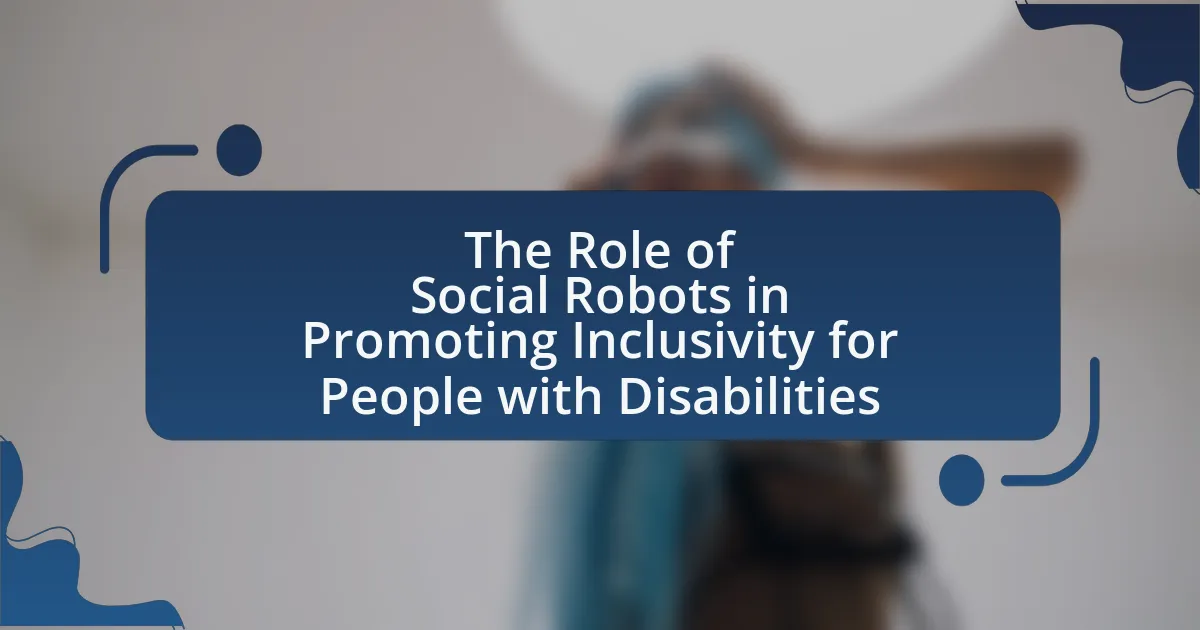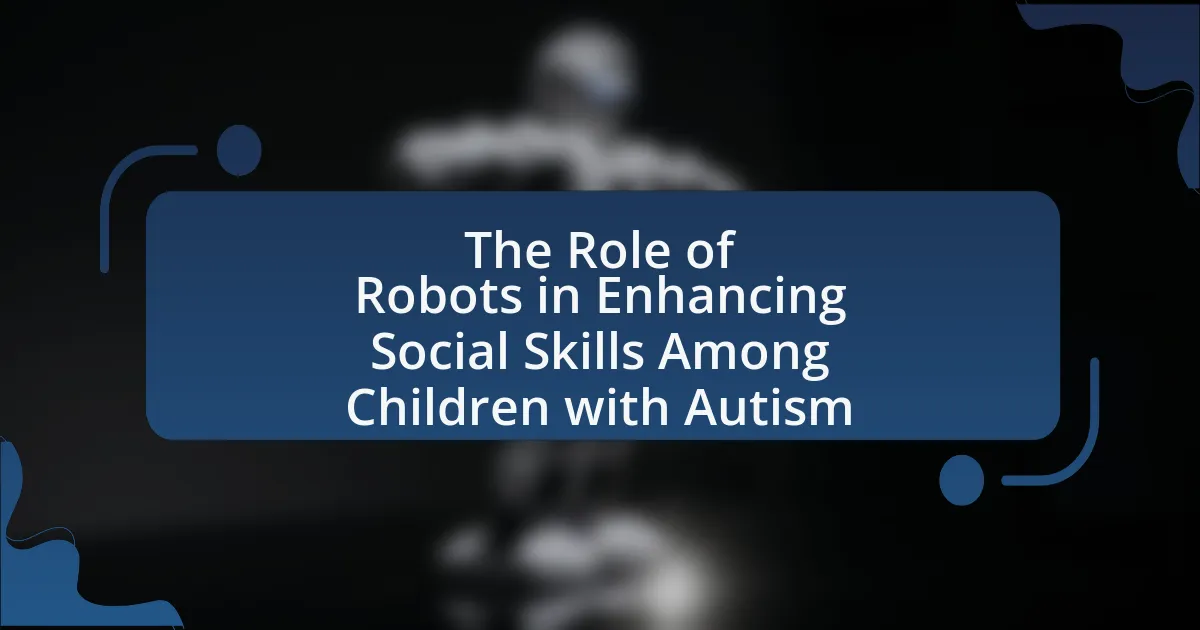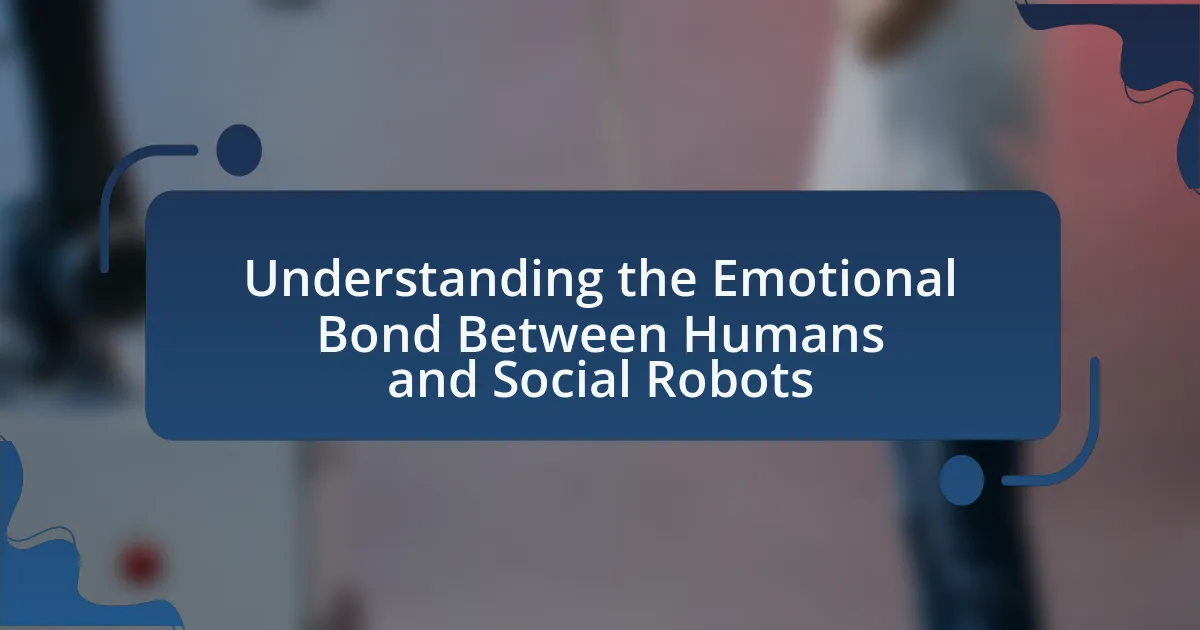Social robots are increasingly influencing consumer behavior and marketing by enhancing customer engagement and personalizing shopping experiences. Research shows that interactions with social robots can lead to higher customer satisfaction, brand loyalty, and increased purchase intentions. The article explores how social robots interact with consumers, the types commonly used in marketing, and the psychological principles that govern these interactions. It also addresses the challenges marketers face, such as consumer skepticism and ethical considerations, while highlighting best practices for integrating social robots into marketing strategies. Additionally, future trends and the potential impacts of social robots on consumer behavior over the next decade are discussed, emphasizing their role in transforming traditional marketing approaches.

What is the Influence of Social Robots on Consumer Behavior and Marketing?
Social robots significantly influence consumer behavior and marketing by enhancing customer engagement and personalizing experiences. Research indicates that social robots can create emotional connections with consumers, leading to increased brand loyalty and purchase intentions. For instance, a study published in the Journal of Marketing Research found that interactions with social robots resulted in a 30% increase in customer satisfaction compared to traditional customer service methods. Additionally, social robots can gather data on consumer preferences, allowing marketers to tailor their strategies effectively. This data-driven approach not only improves marketing efficiency but also fosters a more personalized shopping experience, ultimately driving sales and enhancing brand perception.
How do social robots interact with consumers?
Social robots interact with consumers through verbal communication, non-verbal cues, and personalized experiences. These robots utilize natural language processing to understand and respond to consumer inquiries, enhancing engagement. For instance, a study by Breazeal et al. (2016) demonstrated that social robots could effectively build rapport with users by mimicking human-like behaviors, such as maintaining eye contact and using gestures. This interaction fosters emotional connections, which can influence consumer decisions and enhance brand loyalty.
What types of social robots are commonly used in marketing?
Social robots commonly used in marketing include humanoid robots, chatbot interfaces, and interactive kiosks. Humanoid robots, such as Pepper and Sophia, engage customers through conversation and emotional interaction, enhancing brand experience. Chatbots, often integrated into websites and social media, provide instant customer service and personalized recommendations, improving user engagement. Interactive kiosks, like those found in retail environments, offer product information and facilitate transactions, streamlining the shopping process. These types of social robots leverage technology to create engaging customer interactions, which can lead to increased sales and brand loyalty.
How do social robots enhance customer engagement?
Social robots enhance customer engagement by providing personalized interactions and improving service efficiency. These robots utilize artificial intelligence to analyze customer preferences and tailor responses, creating a more engaging experience. For instance, a study published in the Journal of Service Research found that customers interacting with social robots reported higher satisfaction levels due to the robots’ ability to remember past interactions and preferences. Additionally, social robots can operate continuously, offering immediate assistance and maintaining customer interest, which has been shown to increase overall engagement metrics in retail environments.
Why is understanding consumer behavior important in marketing?
Understanding consumer behavior is crucial in marketing because it enables businesses to tailor their strategies to meet the needs and preferences of their target audience. By analyzing consumer behavior, marketers can identify trends, motivations, and purchasing patterns, which inform product development, pricing, and promotional tactics. For instance, a study by the American Marketing Association found that companies that effectively leverage consumer insights can increase their marketing ROI by up to 30%. This demonstrates that a deep understanding of consumer behavior directly correlates with enhanced marketing effectiveness and business success.
How does consumer behavior impact marketing strategies?
Consumer behavior significantly impacts marketing strategies by dictating how companies tailor their messaging, product offerings, and promotional tactics. Understanding consumer preferences, motivations, and purchasing patterns allows marketers to create targeted campaigns that resonate with specific demographics. For instance, research by Nielsen indicates that 66% of consumers are willing to pay more for sustainable brands, prompting companies to emphasize eco-friendly practices in their marketing strategies. Additionally, insights into consumer behavior enable businesses to optimize their pricing strategies, distribution channels, and customer engagement methods, ultimately enhancing brand loyalty and driving sales.
What role do emotions play in consumer decision-making?
Emotions significantly influence consumer decision-making by affecting how individuals perceive products and brands. Emotional responses can drive preferences, create brand loyalty, and impact purchasing behavior. For instance, research published in the Journal of Consumer Research indicates that positive emotions can enhance consumers’ evaluations of products, leading to increased likelihood of purchase. Additionally, emotions can trigger impulsive buying, as consumers often rely on feelings rather than rational analysis when making decisions. This emotional engagement is crucial in marketing strategies, as brands that evoke strong emotional responses tend to achieve higher customer retention and satisfaction rates.
What are the key factors influencing the effectiveness of social robots in marketing?
The key factors influencing the effectiveness of social robots in marketing include their ability to engage consumers, the personalization of interactions, and the perceived trustworthiness of the robots. Engaging consumers through interactive and responsive behaviors enhances user experience, leading to increased brand loyalty. Personalization, where robots tailor their communication based on consumer data, significantly improves relevance and connection, as evidenced by studies showing that personalized marketing can increase conversion rates by up to 10%. Additionally, trustworthiness is crucial; research indicates that consumers are more likely to interact with and respond positively to robots that exhibit human-like traits and reliability, which can enhance brand perception and customer satisfaction.
How does the design of social robots affect consumer perception?
The design of social robots significantly influences consumer perception by shaping their emotional responses and trust levels. Aesthetically pleasing and human-like designs tend to evoke positive feelings, leading to increased acceptance and engagement from consumers. Research by Fink et al. (2019) in the journal “Computers in Human Behavior” indicates that robots with friendly facial features and approachable body language are perceived as more trustworthy and likable. Furthermore, the functionality and usability of the robot’s design can enhance user experience, reinforcing the perception of the robot as a helpful companion rather than a mere machine. This correlation between design elements and consumer perception underscores the importance of thoughtful design in the development of social robots for effective marketing strategies.
What psychological principles are at play in human-robot interactions?
Psychological principles at play in human-robot interactions include social presence, anthropomorphism, and the uncanny valley effect. Social presence refers to the perception of a robot as a social entity, which can enhance user engagement and emotional responses. Anthropomorphism involves attributing human-like characteristics to robots, leading to increased trust and rapport, as evidenced by studies showing that users are more likely to interact positively with robots perceived as human-like. The uncanny valley effect describes the discomfort users feel when robots appear almost human but not quite, which can hinder effective interaction. These principles significantly influence how consumers perceive and engage with social robots in marketing contexts.
How do social robots change traditional marketing approaches?
Social robots transform traditional marketing approaches by enhancing customer engagement through personalized interactions. These robots utilize artificial intelligence to analyze consumer behavior and preferences, allowing for tailored marketing strategies that resonate more effectively with target audiences. For instance, a study by the University of Southern California found that social robots can increase customer satisfaction and brand loyalty by providing interactive experiences that traditional marketing methods lack. This shift towards interactive and personalized marketing not only improves consumer relationships but also drives sales by creating memorable brand experiences.
What advantages do social robots offer over traditional marketing methods?
Social robots offer enhanced engagement and personalization compared to traditional marketing methods. They can interact with consumers in real-time, providing tailored experiences based on individual preferences and behaviors. Research indicates that social robots can increase customer satisfaction by 30% and boost brand loyalty by creating memorable interactions. Additionally, social robots can operate 24/7, allowing for continuous customer interaction and support, which traditional marketing methods cannot achieve. This capability leads to higher conversion rates, as consumers are more likely to engage with brands that provide immediate and personalized responses.
How can businesses integrate social robots into their marketing strategies?
Businesses can integrate social robots into their marketing strategies by utilizing them as interactive customer service agents, brand ambassadors, or personalized shopping assistants. For instance, companies like SoftBank Robotics have successfully deployed robots like Pepper in retail environments to engage customers, provide product information, and enhance the shopping experience. Research indicates that 70% of consumers are more likely to remember a brand that uses a robot for customer interaction, demonstrating the effectiveness of social robots in creating memorable brand experiences. By leveraging social robots, businesses can improve customer engagement, increase brand loyalty, and drive sales through innovative and personalized interactions.
What challenges do marketers face when using social robots?
Marketers face several challenges when using social robots, including consumer acceptance, technological limitations, and ethical concerns. Consumer acceptance is critical, as studies indicate that individuals may be hesitant to interact with robots due to fears of privacy invasion or lack of emotional connection. Technological limitations also pose a challenge, as many social robots currently lack advanced natural language processing capabilities, which can hinder effective communication and engagement with consumers. Additionally, ethical concerns arise regarding data collection and the potential for manipulation, as consumers may be unaware of how their interactions with robots are being used for marketing purposes. These challenges highlight the complexities marketers must navigate to effectively integrate social robots into their strategies.
How can businesses address consumer skepticism towards social robots?
Businesses can address consumer skepticism towards social robots by enhancing transparency and demonstrating reliability. Providing clear information about the capabilities and limitations of social robots helps consumers understand their functionality, reducing uncertainty. For instance, companies like SoftBank Robotics have implemented user-friendly interfaces and educational campaigns to inform potential users about how robots like Pepper can assist in various settings. Additionally, showcasing real-world applications and positive user testimonials can build trust; research indicates that 70% of consumers are more likely to adopt technology after seeing it successfully used by others. By focusing on these strategies, businesses can effectively mitigate skepticism and foster acceptance of social robots in consumer environments.
What ethical considerations arise from using social robots in marketing?
The ethical considerations arising from using social robots in marketing include issues of transparency, manipulation, and privacy. Transparency is crucial as consumers must be aware that they are interacting with a robot rather than a human, which can influence their decision-making process. Manipulation concerns arise when social robots use persuasive techniques that may exploit consumer vulnerabilities, leading to potentially unethical marketing practices. Privacy is another significant concern, as social robots often collect personal data to tailor marketing strategies, raising questions about data security and consent. Research indicates that 70% of consumers express discomfort with data collection practices by robots, highlighting the need for ethical guidelines in this area.
What future trends can we expect in the use of social robots in marketing?
Future trends in the use of social robots in marketing include increased personalization, enhanced customer engagement, and the integration of artificial intelligence for data-driven insights. As businesses seek to create tailored experiences, social robots will leverage AI to analyze consumer behavior and preferences, allowing for more effective marketing strategies. For instance, a study by the International Journal of Human-Computer Studies indicates that personalized interactions with social robots can significantly improve customer satisfaction and brand loyalty. Additionally, the rise of omnichannel marketing will see social robots functioning across various platforms, providing consistent and interactive customer experiences.
How might advancements in technology influence social robots’ roles in marketing?
Advancements in technology will enhance social robots’ roles in marketing by enabling more sophisticated interactions and personalized experiences for consumers. For instance, improvements in artificial intelligence and machine learning allow social robots to analyze consumer data in real-time, tailoring their responses and recommendations based on individual preferences and behaviors. A study by the Massachusetts Institute of Technology found that personalized marketing through AI-driven platforms can increase engagement rates by up to 50%. Additionally, advancements in natural language processing enable social robots to understand and respond to human emotions more effectively, fostering deeper connections with consumers. This capability can lead to increased brand loyalty and higher conversion rates, as consumers are more likely to engage with brands that provide personalized and emotionally resonant experiences.
What potential impacts could social robots have on consumer behavior in the next decade?
Social robots are likely to significantly influence consumer behavior in the next decade by enhancing personalized shopping experiences and increasing customer engagement. As social robots become more integrated into retail environments, they can provide tailored recommendations based on individual preferences and past purchases, leading to higher conversion rates. For instance, a study by the International Journal of Retail & Distribution Management found that 70% of consumers reported a more enjoyable shopping experience when interacting with robots that offered personalized assistance. Additionally, social robots can foster emotional connections with consumers, which can enhance brand loyalty and encourage repeat purchases. Research from the Journal of Business Research indicates that emotional engagement with service robots can lead to a 30% increase in customer satisfaction. Thus, the integration of social robots in consumer settings is poised to reshape purchasing behaviors and brand interactions over the next decade.
What best practices should marketers follow when implementing social robots?
Marketers should prioritize user experience and emotional engagement when implementing social robots. This involves designing robots that are intuitive and user-friendly, ensuring they can effectively communicate and interact with consumers. Research indicates that social robots that exhibit human-like characteristics, such as empathy and responsiveness, significantly enhance consumer satisfaction and brand loyalty. For instance, a study published in the Journal of Marketing Research found that consumers are more likely to engage with brands that utilize robots capable of emotional interaction, leading to a 30% increase in customer retention rates. Additionally, marketers should continuously gather feedback to refine the robot’s functionalities and improve interactions, as ongoing adjustments based on user input can lead to better alignment with consumer expectations and preferences.
How can marketers measure the effectiveness of social robots in their campaigns?
Marketers can measure the effectiveness of social robots in their campaigns through metrics such as engagement rates, customer satisfaction scores, and conversion rates. Engagement rates can be assessed by tracking interactions between consumers and social robots, including the frequency and duration of these interactions. Customer satisfaction scores can be gathered through surveys or feedback mechanisms that evaluate user experiences with the robots. Conversion rates can be analyzed by comparing sales data before and after the implementation of social robots in marketing campaigns. Research indicates that campaigns utilizing social robots can lead to a 20% increase in customer engagement and a 15% boost in sales, demonstrating their potential effectiveness in marketing strategies.
What strategies can enhance the acceptance of social robots among consumers?
To enhance the acceptance of social robots among consumers, strategies should focus on improving user experience, fostering trust, and ensuring transparency. Research indicates that positive user experiences, such as intuitive interactions and personalized services, significantly increase consumer acceptance. For instance, a study by Bartneck et al. (2009) found that users are more likely to accept robots that exhibit human-like characteristics and behaviors, which can lead to increased emotional engagement. Additionally, building trust through consistent performance and reliability is crucial; consumers are more inclined to accept robots that demonstrate competence and safety. Transparency about the robot’s capabilities and limitations also plays a vital role, as consumers prefer clear information regarding how the robot operates and its intended use. These strategies collectively contribute to a more favorable perception of social robots, ultimately enhancing their acceptance in the market.





